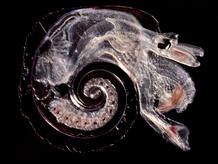
Exhibition of beings found in the Malaspina expedition, unviaje scientist around the world Joan Costa / CSIC
AGENCIES
Malaspina expedition was a oceanographic campaign led by Spain with a score of countries involved in more than 120,000 samples of water, air and gases were collected to study the biodiversity and climate change in 2011
Over the last few years has revealed important results such as the existence of tens of thousands of tons of fish in the ocean and it is expected that the results of the expedition den to talk about for decades .
accumulations match turns plastic waste into the water circulation
In a conference takes place these days in the Private Investigators CSIC in Barcelona, researchers have shown that there are five large accumulations of plastic waste in the open ocean , from samples collected on board.
These accumulations match turns the big five surface water flow ocean. According to these results, the problem of plastic waste pollution has global character.
“Only a global issue as Malaspina could get these results and evaluate the overall abundance of plastic pollution,” said researcher CSIC and coordinator of the Malaspina expedition, Carlos Duarte.
Remote Sites contaminated ocean
Malaspina results revealed also that the entry of pollutants from the atmosphere not only affects coastal areas, but also occurs in the more remote areas of the planet and has already begun to affect the ocean ecosystem .
“We noticed that pollutants enter directly into the ocean through the atmosphere, reaching the most remote areas of the planet, with contributions that are already affecting the ocean ecosystem,” says CSIC researcher and coordinator of the expedition Malaspina Carlos Duarte.
The pollutants enter directly into the ocean through the atmosphere
The issue has generated the first time a database that contains the levels of organic pollutants in all oceans. Researchers have been able to determine how globally distributed dioxins, chemical compounds generated during combustion of organic waste.
“The concentrations are higher near the continents in the central areas of the oceans, a circumstance is explained by the degradation processes during transport and ocean deposited directly from the atmosphere, “explains Jordi Dachs, CSIC researcher at the Institute of Environmental Assessment and Water Research, which also confirms that these pollutants have begun to affect phytoplankton and zooplankton .
Database type oil
In addition, during the project has generated largest database of polycyclic aromatic hydrocarbons (PAH) in the ocean. PAHs are found as part of the fossil fuels and also generated during the combustion of oil and coal.
“We have found that PAH concentrations are greatest near the continents in the central oceanic regions and it produces a diffuse PAH input from atmospheric deposition . This input is greater than the arrival of oil spills and ocean occurs in all oceans, but its impact still unknown, “said Dachs.
The genome of deep ocean
“The Malaspina expedition has been a leap forward in the understanding of the global ocean ecosystem, particularly in the waters below the exposure to sunlight, where we discovered a fish biomass layer to 10 times greater than previously thought, “says Duarte.
Researchers and have begun to sequence the genome of the global deep ocean using more than 2,000 samples of microorganisms collected in the Atlantic, the Indian and the Pacific during the expedition.
This collection of marine microbial genomics, the world’s first global, provide new keys on a reservoir of unexplored biodiversity , because the finding could mean tens of millions of new genes in the coming years.
There are a huge number of unknown species in the deep sea
The sequencing work, framed in Malaspinomics project, focus on the viruses, bacteria and protists that inhabit the ocean to 4,000 feet deep .
Preliminary results Malaspinomics reveal a wealth of previously unknown species of microorganisms in the deep ocean. Specifically, the 60% of bacterial species from the deep ocean detected by techniques of mass sequencing are unknown .
The project coordinator, who had total funding of around six million euros, said in Barcelona that Malaspina marked “a before and after for scientific progress” has managed to “break the boundaries and traditional suspicion between scientific groups.”
“The Spanish oceanography had never led a project with an international dimension of this caliber, with over 18 countries involved,” he concluded.
No comments:
Post a Comment